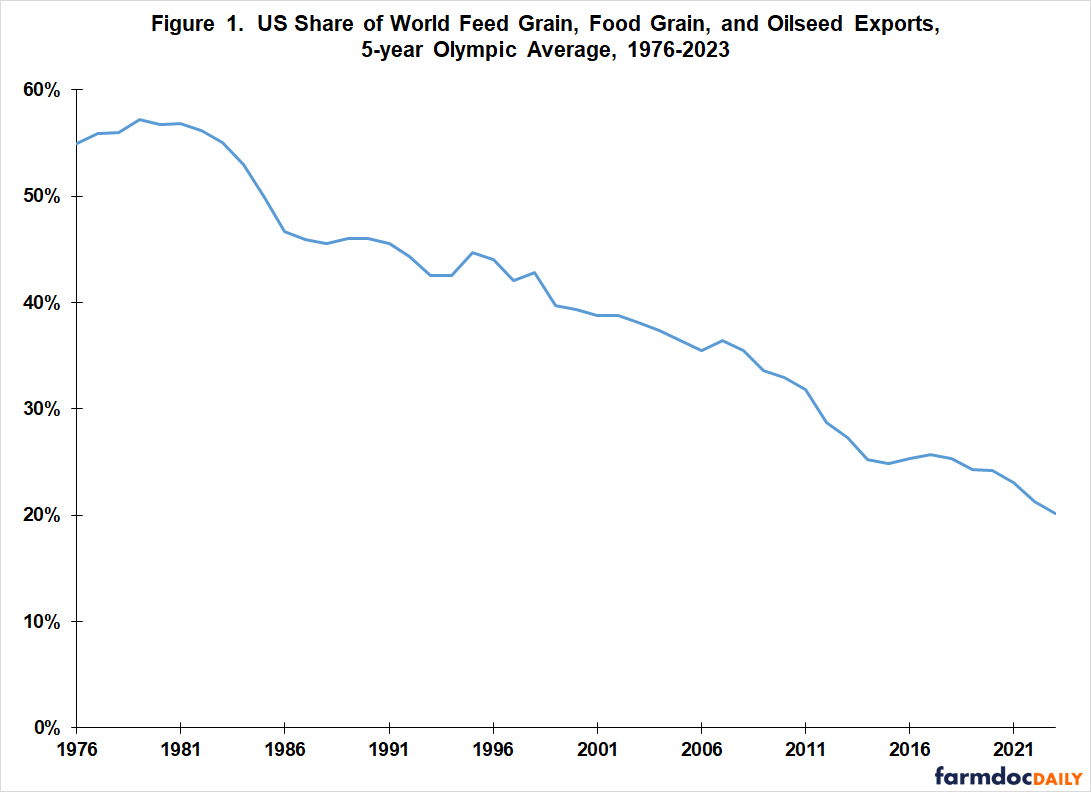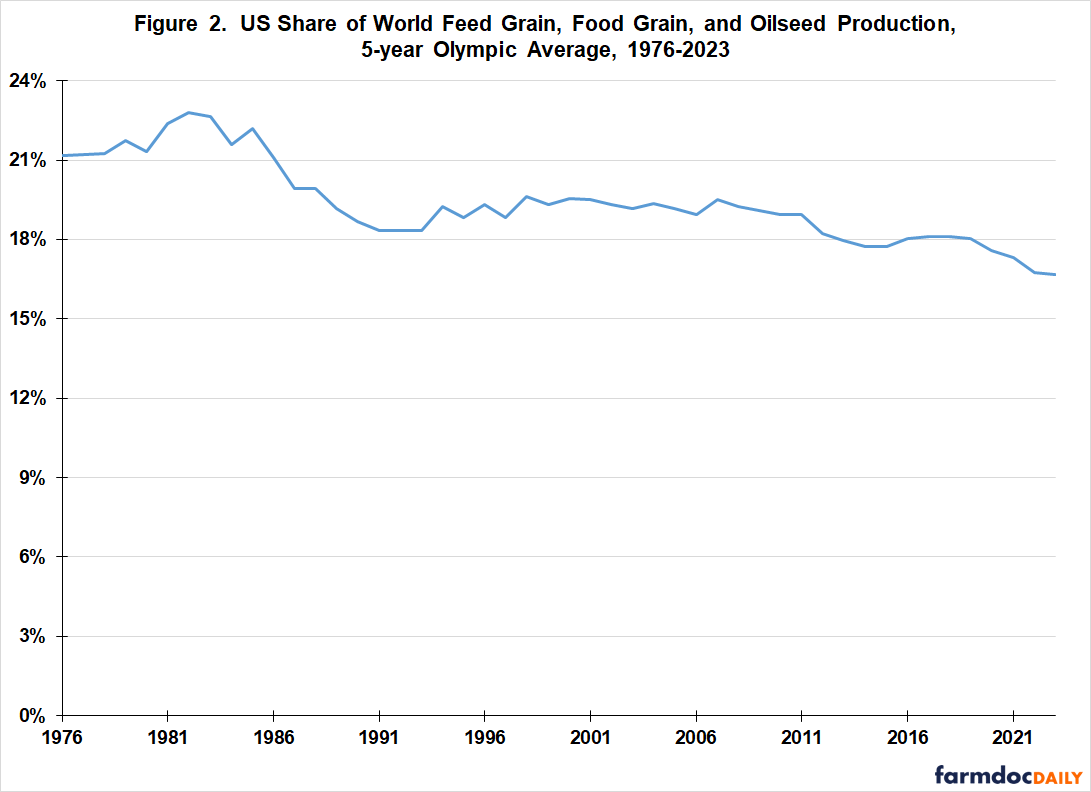Land, not Exports, is the US Field Crop Problem – Part 1, US vs. World
US agricultural exports have emerged as a topic of national concern (see Brasher and farmdoc daily, March 12, 2024). However, land, not exports is the concern the US needs to address to avoid becoming a secondary feed gain, food grain, and oilseed producer. The decline in US share of world production of these crops closely tracks its decline in share of world harvested land. Uncomfortable strategic questions confront the US and US agriculture.
Data
The data in this article are from the PSD (Production, Supply, and Distribution Online) database (US Department of Agriculture, Foreign Agriculture Service). The period of analysis is 1972 through 2023. The analysis starts with the year peanuts were added to the PSD data set. In PSD, feed grains are barley, corn, millet, oats, and sorghum; food grains are rice, rye, and wheat; and oilseeds are cottonseed, peanuts, rapeseed, soybeans, and sunflowers.
Declining US World Export Share
US share of combined world exports of feed grains, food grains, and oilseeds has declined since the early 1980s, or for nearly 50 years (see Figure 1). The decline is persistent and largely consistent, averaging -0.85 percentage point per year or -4.3 percentage points every five years. Current US share in the global market is 20% compared with 57% in 1980.
A 5-year Olympic average share is used because notable year-to-year variations exist in US share due to weather, policy decisions, and other factors. To illustrate the calculation, US share for 2023 is the average of the annual shares from 2019 through 2023 after removing the lowest and highest share.
The decline in US share of world feed grain, food grain, and oilseed exports would look somewhat different if the grains and oilseeds exported in the form of livestock were added into Figure 1. Using data from PSD, US exports of meats and milk products have increased over time. However, US share of world export of milk products and US share of world production of meats and milk products have remained stable since 2007. US share of world export of meats has declined since 2010.
Declining US World Production Share
US share of world production more accurately measures US importance than US share of world exports because it reflects both domestic use and exports. They can offset one another. For example, a reasonable case can be made that the growth in US use of corn for ethanol displaced growth in US corn exports (see farmdoc daily, November 20, 2019).
Like US export share, US share of world feed grain, food grain, and oilseed production has declined since 1980. However, the decline is confined to two periods: the 1980s and post 2007 (see Figure 2). US share of world production was 22.8% in 1982, 18.3% in 1991, 19.5% in 2007, and 16.7% in 2023. It is important to understand why the decline in US share of world production stopped, then restarted.
Importance of Land
US share of harvested world feed grain, food grain, and oilseed land closely tracks US share of world production (see Figure 3). US share of world harvested land was 12.8% in 1983, 11.0% in 1991, 10.7% in 2007, and 9.3% in 2023. Correlation of the two US shares and of their year-to-year change is +0.94 and +0.64, respectively. Perfect correlation is +1.0.
The decline in US share of world harvested land in the mid-1980s is associated with US policy decisions to institute both annual crop year and longer term land retirement programs as part of the response to the return of surplus production after the prosperity of the 1970s and the ensuing farm financial crisis of the 1980s. Idled cropland in the US went from 21 million acres in 1982 to 68 million acres in 1987 (US Department of Agriculture, National Agricultural Statistics Service (USDA, NASS), 1994). The most prominent longer term land retirement program was the Conservation Reserve Program established by the 1985 farm bill.
The decline in US share of world feed grain, food grain, and oilseed production since 2007 has more relevance for the future, in part because it is more recent and in part because it occurred during a period of notable prosperity in the production of these crops in the US (see farmdoc daily, November 8, 2023). The decline in US share of production since 2007 means that output in the rest of the world has been more responsive than output in the US to field crop prosperity. The increase in harvested feed grain, food grain, and oilseed land in the rest of the world is an important factor in their output response (see farmdoc daily, March 6, 2024). The most notable US land response appears to be a more than doubling in the price of US cropland from $2,530/acre in 2007 to $5,460/acre in 2023 (USDA, NASS, March 2024).
Discussion
A declining share of production is often a leading indicator of declining competitiveness. Since 2007, US share of world feed grain, food grain, and oilseed production has declined from 19.5% to 16.7% in 2023, roughly a decline of one percentage point every five years.
Continuation of this rate of decline for another 25 to 30 years (i.e. one generation) will result in the US contributing less than 10% of world production of feed grains, food grains, and oilseeds, likely prompting the question: “Has the US become a secondary crop producer?”
The decline in US share of world harvested land and production of food grains, feed grains, and oilseeds since 2007 is profoundly troubling because production of these crops over this period was particularly profitable. These declines in US market share underscore how binding the US constraint on land is given current technology and policy.
The preceding observations and trends suggest the US is in the process of giving up its historic role as a supplier of basic food staples to the rest of the world. It is problematic that the US can expand exports when harvested land cannot be increased, US yield growth is not dominant vs. the rest of the world, and the rest of the world is expanding harvested land (see farmdoc daily, March 6, 2024; March 20, 2024). “Would the US be better served by converting spending on export promotion programs to spending on research to increase production, including multiple cropping of existing croplands?”
More broadly, the US and US agriculture needs to confront head on this strategic policy question:
“How does the US wish to balance competing demands on its land for food production, energy production, and environmental goods and services, which range from long-standing goods and services such as soil erosion reduction and improved water quality to more recent goods and services such as carbon capture?”
It can be hypothesized that the US is tilting toward a smaller agricultural food production footprint unless the US and US agriculture step forward with a bold, innovative production response. They have done so in the past with the yield revolution; will they do so now with a land-based production revolution?
Data Note
The time paths of US production and harvested land shares diverged somewhat between 1991 and 2007. US share of world production increased while US share of world land declined slightly. Changes in corn’s share of US feed grain, food grain, and oilseed harvested land helps explain this divergence. Corn’s share was 32.2% in 2007 compared with 28.2% in 1991. It has fluctuated around 36% since 2011. Corn’s share of harvested land matters because of its much higher yield. Over the last five crop years, average US yield was 83% higher for corn than for rice, the next highest US crop yield, and 285% higher for corn than for the other grains and oilseeds. When corn’s share of harvested land increases, combined feed grain, food grain, and oilseed output increases even if yields stay the same. For a more in-depth discussion of the importance of the US share of land in corn and soybeans to increasing US feed grain, food grain, and oilseed output, see farmdoc daily, September 22, 2023.
References
Brasher, P. March 20, 2024. What’s behind the US ag trade deficit, and why it could be hard to shrink. Agri-Pulse Newsletter. Volume 20, Number 12.
Colussi, J., N. Paulson, J. Janzen and C. Zulauf. "U.S. Dominance in Corn Exports on the Wane Due to Brazilian Competition." farmdoc daily (14):50, Department of Agricultural and Consumer Economics, University of Illinois at Urbana-Champaign, March 12, 2024.
US Department of Agriculture, Foreign Agriculture Service. March 2024. Production, Supply, and Distribution Online. https://apps.fas.usda.gov/psdonline/
US Department of Agriculture, National Agricultural Statistics Service. 1994. Agricultural Statistics: 1994. Washington: US Government Printing Office. https://usda.library.cornell.edu/concern/publications/j3860694x?locale=en
US Department of Agriculture, National Agricultural Statistics Service. March 2024. QuickStats. https://quickstats.nass.usda.gov/
Zulauf, C. "Has Ethanol Increased Total US Corn Use?" farmdoc daily (9):219, Department of Agricultural and Consumer Economics, University of Illinois at Urbana-Champaign, November 20, 2019.
Zulauf, C., J. Colussi, N. Paulson and G. Schnitkey. "Assessing US Performance: Land and 21st Century Field Crop Production." farmdoc daily (14):46, Department of Agricultural and Consumer Economics, University of Illinois at Urbana-Champaign, March 6, 2024.
Zulauf, C., J. Colussi, N. Paulson and G. Schnitkey. "Exploring Yield Growth: US Crops in a Global 21st Century Context." farmdoc daily (14):56, Department of Agricultural and Consumer Economics, University of Illinois at Urbana-Champaign, March 20, 2024.
Zulauf, C. and G. Schnitkey. "The Post 2006 New Normal: US Grain and Oilseed Profitability." farmdoc daily (13):204, Department of Agricultural and Consumer Economics, University of Illinois at Urbana-Champaign, November 8, 2023.
Zulauf, C., G. Schnitkey, N. Paulson and J. Colussi. "Concentration of US Crops in Corn and Soybeans: Importance to Increasing US Production of Grains and Oilseeds." farmdoc daily (13):173, Department of Agricultural and Consumer Economics, University of Illinois at Urbana-Champaign, September 22, 2023.
Disclaimer: We request all readers, electronic media and others follow our citation guidelines when re-posting articles from farmdoc daily. Guidelines are available here. The farmdoc daily website falls under University of Illinois copyright and intellectual property rights. For a detailed statement, please see the University of Illinois Copyright Information and Policies here.










